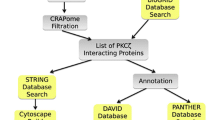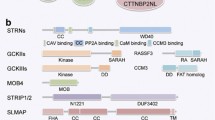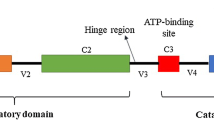Abstract
Signal transduction pathways control various biological processes in cells leading to distinct cellular functions. Protein–protein interactions and post-translational modifications are the physiological events that occur in signaling pathway. p38 MAPK are known to be involved in regulating wide range of cellular processes by interacting and activating relevant signaling molecules by means of phosphorylation. Deregulation of p38 MAPK is associated with various pathological conditions. In order to get an insight into the role played by p38 MAPK in cellular signaling, studies were carried out to identify proteins that interact with p38 MAPK. Mass spectrometry was used to identify the proteins present in p38 MAPK complex obtained by co-immunoprecipitation. Based on mass spectrometry data, here we report insulin-like growth factor-II binding protein 1 (IGF2BP1) as a novel interacting partner of p38 MAPK. IGF2BP1 is a RNA-binding protein predominantly known to be involved in tumor progression. To reconfirm the mass spectrometry data, in silico analysis was carried out. Based on different models predicted in silico, we report the possible interaction domains of p38MAPK and IGF2BP1. Considering the involvement of p38MAPK and IGF2BP1 in cancer, our study opens up the possibility of p38MAPK regulating IGF2BP1 function, and the possibility of targeting this novel interaction for developing cancer-treating drugs is discussed.



Similar content being viewed by others
References
Venigalla RKC, Turner M (2012) RNA binding proteins as a point of convergence of the PI3K and p38MAPKpathways. Front Immunol 3:398. doi:10.3389/fimmu.2012.00398
GhignaC Cartegni L, Jordan P, Paronetto MP (2015) Posttranscriptional regulation and RNA binding proteins in cancer biology. Biomed Res Int 2015:897821. doi:10.1155/2015/897821
Ross AF, Oleynikov Y, Kislauskis EH, Taneja KL, Singer RH (1997) Characterization of a β-actin mRNA zipcode-binding protein. Mol Cell Biol 17:2158–2165
Havin L, Git A, Elisha Z, Oberman F, Yaniv K, Schwartz SP, Standart N, Yisraeli JK (1998) RNA-binding protein conserved in both microtubule- and microfilament-based RNA localization. Genes Dev 12:1593–1598. doi:10.1101/gad.12.11.1593
Doyle GA, Betz NA, Leeds PF, Fleisig AJ, Prokipcak RD, Ross J (1998) The c-myc coding region determinant-binding protein: a member of a family of KH domain RNA-binding proteins. Nucleic Acids Res 26:5036–5044
Leeds P, Kren BT, Boylan JM, Betz NA, Steer CJ, Gruppuso PA, Ross J (1997) Developmental regulation of CRD-BP, an RNA-binding protein that stabilizes c-myc mRNA in vitro. Oncogene 14(11):1279–1286. doi:10.1038/sj.onc.1201093
Ross J, Lemm I, Berberet B (2001) Overexpression of an mRNA binding protein in human colorectal cancer. Oncogene 20:6544–6550. doi:10.1038/sj.onc.1204838
Ioannidis P, Trangas T, Dimitriadis E, Samiotaki M, Kyriazoglou I, Tsiapalis CM, Kittas C, Agnantis N, Nielsen FC, Nielsen J, Christiansen J, Pandis N (2001) C-myc and IGF-II mRNA-binding protein (CRD BP/IMP-1) in benign and malignant mesenchymal tumours. Int J Cancer 94(4):480–484
Ioannidis P, Mahaira L, Papadopoulou A, Teixeira MR, Heim S, Andersen JA, Evangelou E, Dafni U, Pandis N, Trangas T (2003) 8q24 copy number gains and expression of the c-myc mRNA stabilizing protein CRD-BP in primary breast carcinomas. Int J Cancer 104(1):54–59. doi:10.1002/ijc.10794
Bernstein PL, Herrick DJ, Prokipcak RD, Ross J (1992) Control of c-myc mRNA half-life in vitro by a protein capable of binding to a coding region stability determinant. Genes Dev 6:642–654. doi:10.1101/gad.6.4.642
Dai N, Rapley J, Angel M, Yanik MF, Blower MD, Avruch J (2011) mTOR phosphorylates IMP2 to promote IGF2 mRNA translation by internal ribosomal entry. Genes Dev 25(11):1159–1172. doi:10.1101/gad.2042311
Bell JL, Wachter K, Muhleck B, Pazaitis N, Kohn M, Lederer M, Huttelmaier S (2013) Insulin-like growth factor 2 mRNA-binding proteins (IGF2BPs): post-transcriptional drivers of cancer progression? Cell Mol Life Sci 70:2657–2675. doi:10.1007/s00018-012-1186-z
Nielsen J, Christiansen J, Lykke-Andersen J, Johnsen AH, Wewer UM, Nielsen FC (1999) A family of insulin-like growth factor II mRNA-binding proteins represses translation in late development. Mol Cell Biol 19:1262–1270. doi:10.1128/MCB.19.2.1262
Suvasini R, Shruti B, Thota B, Shinde SV, Friedmann-Morvinski D, Nawaz Z, Prasanna KV, Thennarasu K, Hegde AS, Arivazhagan A, Chandramouli BA, Santosh V, Somasundaram K (2011) Insulin growth factor-2 binding protein 3 (IGF2BP3) is a glioblastoma-specific marker that activates phosphatidylinositol 3-kinase/mitogen-activated protein kinase (PI3K/MAPK) pathways by modulating IGF-2. J Biol Chem 286(29):25882–25890. doi:10.1074/jbc.M110.178012
Stohr N, Kohn M, Lederer M, Glass M, Reinke C, Singer RH, Huttelmaier S (2012) IGF2BP1 promotes cell migration by regulating MK5 and PTEN signaling. Genes Dev 26(2):176–189. doi:10.1101/gad.177642.111
Tanoue T, Adachi M, Moriguchi T, Nishida E (2000) A conserved docking motif in MAP kinases common to substrates, activators and regulators. Nat Cell Biol 2:110–116. doi:10.1038/35000065
Cuenda A, Rousseau S (2007) p38 MAP-Kinases pathway regulation, function and role in human diseases. Biochim Biophys Acta 1773:1358–1375. doi:10.1016/j.bbamcr.2007.03.010
Brook M, Tchen CR, Santalucia T, McIlrath J, Arthur JS, Saklatvala J, Clark AR (2006) Posttranslational regulation of tristetraprolin subcellular localization and protein stability by p38 mitogen-activated protein kinase and extracellular signal-regulated kinase pathways. Mol Cell Biol 26:2408–2418. doi:10.1128/MCB.26.6.2408-2418.2006
Wang Z, Canagarajah BJ, Boehm JC, Kassisà S, Cobb MH, Young R, Abdel-Meguid S, Adams JL, Goldsmith EJ (1998) Structural basis of inhibitor selectivity in MAP kinases. Structure 6:1117–1128. doi:10.1016/S0969-2126(98)00113-0
Chao JA, Patskovsky Y, Patel V, Levy M, Almo SC, Singer RH (2010) ZBP1 recognition of beta-actin zipcode induces RNA looping. Genes Dev 24(2):148–158. doi:10.1101/gad.1862910
Guex N, Peitsch MC (1997) SWISS-MODEL and the Swiss-PdbViewer: an environment for comparative protein modeling. Electrophoresis 18:2714–2723. doi:10.1002/elps.1150181505
Grosdidier S, Pons C, Solernou A, Fernández-Recio J (2007) Prediction and scoring of docking poses with pyDock. Proteins 69(4):852–858. doi:10.1002/prot.21796
Laskowski RA, Swindells MB (2011) LigPlot+: multiple ligand-protein interaction diagrams for drug discovery. J Chem Inf Model 51(10):2778–2786. doi:10.1021/ci200227u
Smith GR, Sternberg MJE (2002) Prediction of protein–protein interactions by docking methods. Curr Opin Struct Biol 12:28–35. doi:10.1016/S0959-440X(02)00285-3
Thirumal Kumar D, George Priya Doss C, Sneha P, Tayubi IA, Siva R, Chakraborty C, Magesh R (2016) Influence of V54M mutation in giant muscle protein titin: a computational screening and molecular dynamics approach. J Biomol Struct Dyn. doi:10.1080/07391102.2016.1166456
Bashford D (2004) Macroscopic electrostatic models for protonation states in proteins. Front Biosci 9:1082–1099
Honig B, Nicholls A (1995) Classical electrostatics in biology and chemistry. Science 268:1144–1149. doi:10.1126/science.7761829
Warshel A, Aqvist J (1991) Electrostatic energy and macromolecular function. Annu Rev Biophys Biophys Chem 20:267–298
Sunnerhagen P (2007) Cytoplasmatic post-transcriptional regulation and intracellular signaling. Mol Genet Genom 277(4):341–355. doi:10.1007/s00438-007-0221-5
Zarubin T, Han J (2005) Activation and signaling of the p38 MAP kinase pathway. Cell Res 15:11–18. doi:10.1038/sj.cr.7290257
Cuadrado A, Nebreda AR (2010) Mechanisms and functions of p38 MAPK signalling. Biochem J 429(3):403–417. doi:10.1042/BJ20100323
Lucey BP, Nelson-Rees WA, Hutchins GM (2009) Henrietta Lacks, HeLa cells, and cell culture contamination. Arch Pathol Lab Med 133(9):1463–1467. doi:10.1043/1543-2165-133.9.1463
Pearson G, Robinson F, Beers Gibson T, Xu BE, Karandikar M, Berman K, Cobb MH (2001) Mitogen-activated protein (MAP) kinase pathways: regulation and physiological functions. Endocr Rev 22(2):153–183. doi:10.1210/edrv.22.2.0428
Vakser IA (2014) Protein–protein docking: from interaction to interactome. Biophys J 107:1785–1793. doi:10.1016/j.bpj.2014.08.033
Sneha P, Doss CG (2016) Gliptins in managing diabetes—Reviewing computational strategy. Life Sci 166:108–120. doi:10.1016/j.lfs.2016.10.009
Jacob R, Anbalagan M (2016) Targeting secret handshakes of biological processes for novel drug development. Front Biol 11(2):132–140. doi:10.1007/s11515-016-1394-2
Yaniv K, Yisraeli JK (2002) The involvement of a conserved family of RNA binding proteins in embryonic development and carcinogenesis. Gene 287:49–54. doi:10.1016/S0378-1119(01)00866-6
Stohr N, Lederer M, Reinke C, Meyer S, Hatzfeld M, Singer RH, Huttelmaier S (2006) ZBP1 regulates mRNA stability during cellular stress. J Cell Biol 175(4):527–534. doi:10.1083/jcb.200608071
Igea A, Nebreda AR (2015) The Stress Kinase p38α as a Target for Cancer Therapy. Cancer Res 75(19):3997–4002. doi:10.1158/0008-5472.CAN-15-0173
Acknowledgements
This study was funded by the Department of Biotechnology, Govt. of India (Grant No: BT/PR6207/GBD27/381/2012) (M. A). R.J is a Maulana Azad National Fellow of University Grants Commission, Govt. of India.
Author information
Authors and Affiliations
Corresponding author
Ethics declarations
Conflict of interest
The authors declare they have no conflict of interest.
Rights and permissions
About this article
Cite this article
Rini, J., Anbalagan, M. IGF2BP1: a novel binding protein of p38 MAPK. Mol Cell Biochem 435, 133–140 (2017). https://doi.org/10.1007/s11010-017-3062-5
Received:
Accepted:
Published:
Issue Date:
DOI: https://doi.org/10.1007/s11010-017-3062-5




